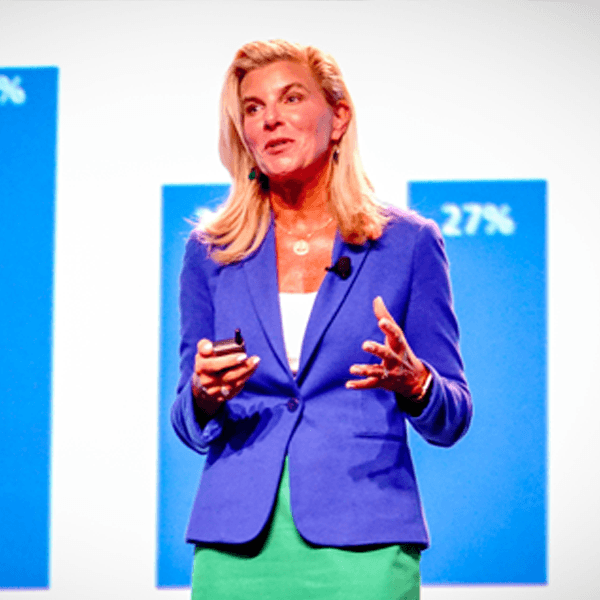LOS ANGELES — The path for branded consumer packaged goods manufacturers to win at the shelf has never been more difficult, with most “building new muscle” by changing the way they allocate resources to retailers, scrutinizing their return on data and digital marketing investments and engaging shoppers in new, creative ways, according to Advantage President, Enterprise Client Solutions Jill Blanchard.
“We’re in for a different and exciting chapter,” Blanchard said during the “Thriving in a New Retail Environment” session at the NielsenIQ C360 conference in Los Angeles. “We’re smarter than we’ve ever been because we have been forced to implement untested strategies to address unprecedented challenges. For an industry that has been so fond of modeling history, this is way out of our comfort zone and has forced us to build new muscle.”
As retailers react to list price and other costs increases by expanding their private-brand assortments — more than 70% of retailers surveyed by Advantage said they are expanding their private-brand SKUs by up to 10% — manufacturers are getting creative about how they are positioning their products and marketing to consumers, she said. “Consumers are seeking value, and manufacturers are bringing trade marketing back, with secondary displays their top tool to remain competitive at the shelf, followed by digital couponing and supporting retailer-focused marketing programs.”
Now, however, manufacturers are using surgical precision when creating their promotional plans, Blanchard noted. “Two-thirds of surveyed manufacturers have changed the way they allocate resources by retail customer, basing their decisions on more precise financial models that demonstrate which retailers are driving what profits and which have significant potential for growth. Their investments in retail data and retailer’s digital platforms are now closely scrutinized with an ROI lens— if they can’t prove it out, they’re not making the investment.”
As CPG brands lose shelf space to retailers’ own brands, many manufacturers are marketing the quality of their products and launching new products, she said. “Innovation is back! More than 90 percent of manufacturers we surveyed said they are bringing more innovation to market this year — and one-third are aggressively pursuing this strategy — and this comes at a perfect time as retailers seek differentiation as a strategy to capture more shopping trips.”
New marketing strategies
During the learning session, Blanchard was joined by two Advantage business partners, Brian VanCleave, vice president commercial strategy and operations for Bayer, and Amy Luke Busker, senior vice president, branded sales for Mizkan, who shared their strategies for continued growth.
Bayer’s trade spending strategy is evolving, VanCleave said. The company is focusing on predictive analytics, with an emphasis on real-time testing rather than attempting to predict the future with regression analysis. “The past has never been less relevant to determining the future,” he noted.
The company is also rebalancing its investment by reconsidering its customer segmentation. “Priority retailers are the priority,” he noted, “but there must be balance with the rest of the market.”
To recharge its positioning at the shelf, Mizkan leveraged its iconic Ragu brand’s 86-year heritage and unique yellow-and-red color palette with a new visual identity and catchy “Cook like a mother” tagline that’s effective on physical and digital shelves. “We are emphasizing Ragu’s broad appeal and focusing on our value proposition and how to further stretch mealtime,” Luke Busker noted, adding the “Cook like a mother” campaign won a silver Reggie Award from the Association of National Advertisers.
Mizkan also powered up innovation with 13 new items, including the Ragu Kettle Cooked line, a premium-positioned subline compared to its flagship Old World Style Ragu. “This was a very big decision to make amid COVID-related supply chain disruption,” she said.
With a new brand identity for Ragu, Mizkan is recharging its sales and retail strategy, using retail execution to drive omnichannel success. “We dove into whitespace to further our brand’s physical presence and elevated our approach to innovation sell-in with product tastings with top partners,” Luke Busker said.
Blanchard noted that retailers and manufacturers must continue to pivot as consumers’ shopping habits continue to change. “Think back to 2019. What tripped your trigger to buy a product?” she asked. “How do you shop now? Do you do any online research beforehand or even at-shelf in the moment? Does any of your regular grocery shopping now show up at your front door? I was literally clipping digital coupons last week while waiting to check out at my local Jewel store. And let’s talk about that trigger: Immediacy has moved up to one of the top triggers to purchase, alongside quality and price. So, it’s not just about the best price at shelf anymore.”
